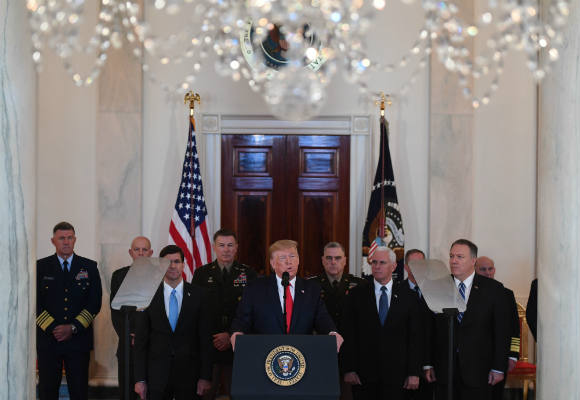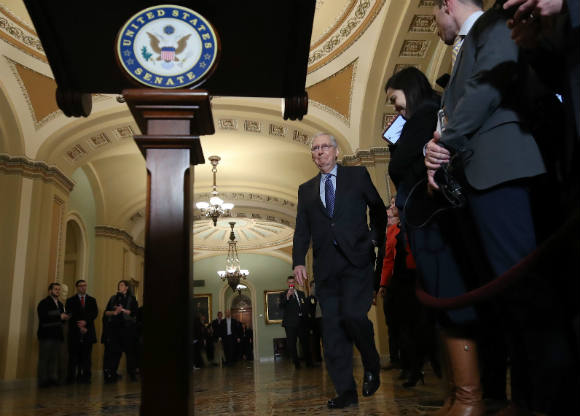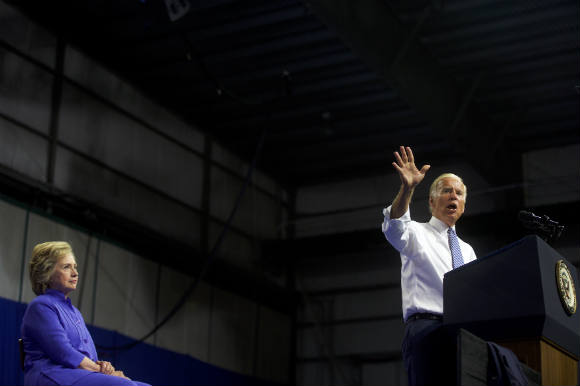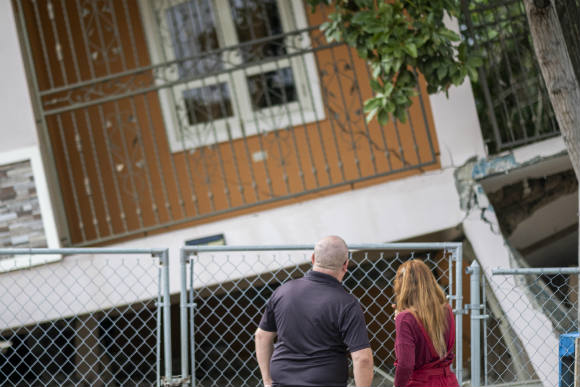The Hill’s Morning Report – Deescalation: US-Iran conflict eases

Welcome to The Hill’s Morning Report. It’s Thursday! Our newsletter gets you up to speed on the most important developments in politics and policy, plus trends to watch. Alexis Simendinger and Al Weaver are the daily co-creators, so find us @asimendinger and @alweaver22 on Twitter and recommend the Morning Report to your friends. CLICK HERE to subscribe!
President Trump on Wednesday took a step backward from continued military aggression against Iran and endorsed less lethal tools to try to prevent Tehran from acquiring a nuclear weapon and to pressure it to change its “behavior.”
During a brief White House statement that produced sighs of relief in global capitals and on Wall Street, Trump announced that Iran’s ballistic missile strikes against two U.S. bases located inside Iraq resulted in little damage and no American or Iraqi casualties and ended with Iran “standing down.”
The Hill: Trump takes an off-ramp in the Iran crisis.
The president defended his decision last week to order the drone killing in Baghdad of Iranian Gen. Qassem Soleimani, leader of Iran’s Quds Force, arguing it saved American lives and conveyed a warning to terrorists that “if you value your own life, you will not threaten the lives of our people.”
Trump ordered unspecified additional economic sanctions against Iran — a country already so strangled by U.S. sanctions that the president in September declared the country “broke.” He said Iran would not be “allowed” to have a nuclear weapon on his watch, but he also appeared to concede that tearing up the Obama-era international nuclear deal signed with Iran in 2015, as he did in 2018, would not halt Tehran’s race to become a nuclear power.
“Break away,” Trump advised France, Germany, China, Russia, the United Kingdom and the European Union, referring to the nuclear pact they helped craft with Iran that lifted sanctions in exchange for restrictions and inspections intended to slow its nuclear capabilities.
In a surprise move, the president said he would ask the North Atlantic Treaty Organization (NATO), a post-World War II military alliance he has often criticized, to “become more involved in the Middle East process.” He did not explain either a “process” or role he envisioned for NATO.
Shortly after Trump spoke, top administration officials fanned out to brief House and Senate lawmakers on Capitol Hill, fielding tough questions about the intelligence Trump relied on to justify killing Soleimani as an imminent threat.
Democratic lawmakers, along with several Republican senators, exited closed-door sessions saying they were dissatisfied with vague answers from Trump’s national security team and the political spin they heard.
The Hill: Democrats “utterly unpersuaded” by evidence behind Trump’s Soleimani drone strike.
Sen. Mike Lee (R-Utah) objected that Trump’s briefers told lawmakers, “‘We can’t have dissension within our ranks, within our government, or else it sends the wrong signal to the Iranians.’ I just think that’s completely wrong.”
Niall Stanage: The Memo: Trump turns down the heat.
The House will vote today on a resolution that would limit Trump’s war-making power against Iran. Congressional debate about the War Powers Act also dogged Trump’s predecessors, former Presidents George W. Bush and Obama, but since 2001, the post-9/11 risks of terror attacks have persuaded lawmakers to grant the commander in chief the authority to take military action against U.S. enemies and ask Congress for its support later.
The Hill: House to vote today to limit Trump’s war-making power against Iran.
The Hill: Trump, Democrats set for brawl on Iran war powers.
Although the president suggested Iran retreated from escalating to the brink of war, ballistic missiles may yet be overtaken by clandestine cyberattacks authorized by Tehran or its proxies.
The Washington Post reported, citing unnamed Trump administration officials, that Iraqis and intelligence sources conveyed to the United States in advance that missile attacks against U.S. facilities would be Tehran’s retaliatory response to Soleimani’s killing. “It’s not luck that no one got killed,” a senior defense official said.
The heads-up, even without specifics about intended targets, gave military commanders sufficient time to move U.S. troops to safe, fortified positions at bases in Iraq. The New York Times also detailed how the administration prepared during the early-alert window that began on Tuesday at 2 p.m.
The next moves by Tehran may not be as transparent. Iran has the ability to access private sector and government computers in the United States and to “burn down the system,” warned Christopher Krebs, the director of the Cybersecurity and Infrastructure Security Agency, the Department of Homeland Security’s computer security arm.
The New York Times: Iran’s retaliation with missiles may be “concluded,” but cyberwarfare threat grows.
CNN: FBI, Homeland Security warn of Iranian terror and cyber threat in new intelligence bulletin.

LEADING THE DAY
IMPEACHMENT WATCH: The wait is on for Speaker Nancy Pelosi (D-Calif.) to send the two articles of impeachment to the Senate, especially as some within her own party are clamoring for her to do so more than three weeks after the House made Trump the third president to impeached in U.S. history.
Pelosi has continued to hold back sending the articles despite Senate Majority Leader Mitch McConnell’s (R-Ky.) announcement that he has the votes to start the Senate trial under the precedent set by the 1999 impeachment of former President Clinton and without agreeing on a deal over witnesses. But the wait has drawn the ire of some Democrats who believe she should send them over sooner rather than later.
“If we’re going to do it, she should send them over. I don’t see what good delay does,” said Sen. Dianne Feinstein (D-Calif.), echoing remarks made by Sens. Chris Murphy (D-Conn.) and Joe Manchin (D-W.Va.) on Tuesday (The Hill).
Pelosi indicated on Wednesday that she won’t send them over until the text of the Senate resolution emerges (The Hill).
“We are waiting to see what the terms are,” Pelosi told reporters Wednesday morning. “As I said from the beginning, how we choose our managers depends on what the arena … we are going into.”
The Hill: House Majority Leader Steny Hoyer (D-Md.) says House Dems reserving option to subpoena John Bolton.
The Washington Post: GOP leaders spar over adding House members to Trump’s impeachment defense team.
McConnell, however, indicated that there will not be any negotiating with Pelosi or House Democrats over how the impeachment process will work in the upper chamber (The Hill).
“There will be no haggling with the House over Senate procedure,” McConnell said. “The House Democrats’ turn is over.”
“My Democratic friends are losing patience,” McConnell said, referring to the comments by Murphy, Manchin and Sen. Angus King (I-Maine), adding that Pelosi has an “endless appetite for these cynical games.”
The Associated Press: Impeachment standoff deepens, testing McConnell and Pelosi.
The Hill: Pressure building on Pelosi over articles of impeachment.
Roll Call: Chief Justice John Roberts would hold the gavel, but not the power, at Trump impeachment trial.
The Associated Press: Sen. Cory Booker (D-N.J.): Impeachment trial could be “big blow” to my campaign.

IN FOCUS/SHARP TAKES
POLITICS & CAMPAIGNS: Is former Vice President Joe Biden the 2020 version of Hillary Clinton? It’s a question some Democrats are being forced to examine as the primary battle nears the Iowa caucuses and Biden finds himself locked in a fight with Sen. Bernie Sanders (I-Vt.) in early primary states.
As Amie Parnes writes, the question cropped up again after a recent Iowa town hall when he was asked whether he was running a better campaign than Clinton’s in 2016, but the answer remains a tough one for Democrats who still worry about some of Biden’s more glaring weaknesses heading into the early voting season.
“No one wants déjà vu,” said one Democratic strategist who has worked on presidential campaigns. “And the big fear is that it will be just that.”
The Hill: Poll: Trump tied with Biden in Arizona.
The New York Times: How Sen. Elizabeth Warren (D-Mass.) is being squeezed by two Democratic factions.
Steve Peoples, The Associated Press: Trump changes terms of 2020 race with Iran turmoil.
The Wall Street Journal: Elizabeth Warren’s base is getting anxious.

> Senate state of play: Senate Republicans are playing defense in this year’s race to maintain their majority, but Democrats likely have a tough fight ahead in their third consecutive bid to retake control of the chamber.
As Max Greenwood writes in his latest look at the Senate map in 2020, Republicans are defending two dozen seats in November. Democrats need to pick up four seats in 2020 – three if a Democrat is elected president – to take control of the chamber and are looking at flipping a number of seats in states where the president’s approval rating is underwater.
Complicating matters for Democrats, Sen. Doug Jones (D-Ala.), is among the most vulnerable senators up for reelection this year, gumming up the path for the minority party to regain control of the Senate. Headlining Greenwood’s list of the most vulnerable senators are Jones, Cory Gardner (R-Colo.) and Martha McSally (R-Ariz.).
> Deepfakes: Facebook’s global policy chief faced tough questions before a House panel on Wednesday as lawmakers voiced skepticism over the company’s efforts to crack down on manipulated videos known as deepfakes ahead of the 2020 elections.
The social media giant unveiled plans to ban such videos late Monday night, but critics quickly condemned the policy for not going far enough. According to the new guidelines, neither the video of Pelosi edited to make her appear intoxicated, which went viral last year, nor a clip of Biden manipulated to falsely depict white nationalist views would be taken down.
“Big Tech failed to respond to the grave threats posed by deepfakes, as evidenced by Facebook scrambling to announce a new policy that strikes me as wholly inadequate,” said Rep. Jan Schakowsky (D-Ill.), the House Energy and Commerce Subcommittee on Consumer Protection and Commerce chairwoman, noting that the video of Pelosi has already been viewed millions of times (The Hill).
The Hill: Here’s a look at states in which Michael Bloomberg’s campaign is investing in ads.
The Morning Report is created by journalists Alexis Simendinger and Al Weaver. We want to hear from you! Email: asimendinger@digital-staging.thehill.com and aweaver@digital-staging.thehill.com. We invite you to share The Hill’s reporting and newsletters, and encourage others to SUBSCRIBE!
OPINION
The Bill Clinton trial cannot serve as the model for the Donald Trump trial, by Allan Lightman, opinion contributor, The Hill. https://bit.ly/2TglR9V
Tensions with Iran will not be reduced by erratic decisions, by former Rep. Steve Israel (D-N.Y.), opinion contributor, The Hill. https://bit.ly/2QWPOsF
WHERE AND WHEN
Hill.TV’s “Rising” program features Barbara Slavin, director of the Future of Iran Initiative at the Atlantic Council, and Rep. Ruben Gallego (D-Ariz.) to discuss the Iran situation; Zach Montellaro, campaign reporter for Politico, to talk about 2020 primary polling and debate qualifications; and Wesley Yang, columnist for Tablet magazine. Coverage starts at 9 a.m. ET at http://digital-staging.thehill.com/hilltv or on YouTube at 10 a.m. at Rising on YouTube.
The House meets at 10 a.m. Pelosi holds a news conference at 10:45 a.m. House Minority Leader Kevin McCarthy (R-Calif.) holds his weekly press event at 11:30 a.m.
The Senate convenes at 10 a.m. and continues to consider executive and judicial nominees for confirmation.
The president will announce proposed National Environmental Policy Act regulations at 11 a.m. and receive his intelligence briefing at 2 p.m. He will also hold a reelection rally in Toledo, Ohio, at 7 p.m.
Vice President Pence will travel to Ohio to introduce the president at a reelection rally. He returns to Washington tonight.
The U.S. Chamber of Commerce hosts discussions about the “2020 State of American Business” from 10 a.m. to 12:30 p.m., including an opening speech by Chamber CEO Tom Donahue, at its headquarters in Washington. Information and webcast HERE.
ELSEWHERE
➔ Ukraine Airlines crash: Authorities in Iran said they recovered the so-called black boxes from the Boeing 737-800 passenger jet that crashed shortly after takeoff on Wednesday in Tehran bound for Ukraine with 176 people aboard. All passengers and crew members perished in a fiery disaster that Iran immediately blamed on mechanical troubles. Officials in the United States, Canada and Ukraine said the crash should be fully investigated, but it was unclear how much access to the cockpit conversations and instrument data international investigators may be granted.
Reuters reported that the initial assessment of Western intelligence agencies was that the plane had not been brought down by a missile. There was evidence one of the jet’s engines overheated, according to one unnamed source from Canada. Among the victims of the crash were at least 63 Canadians, prompting Canadian officials to seek Tehran’s cooperation and to offer technical assistance (The Associated Press).
➔ Supreme Court: Justice Ruth Bader Ginsburg, who has battled recurring health problems during decades on the high court, sounded a positive note this week about the state of her health. “I’m cancer free,” she told CNN during an interview on Tuesday. “That’s good.” The 86-year-old justice, appointed by former President Clinton, was treated for a cancerous pancreatic tumor in August. Previously, Ginsburg was treated for breast cancer and early stage lung cancer (The Hill).
➔ In The Know: Prince Harry and Meghan Markle announced on Wednesday that they plan to take a “step back” as senior members of the British royal family, a revelation that surprised Buckingham Palace. According to a statement, the couple plan to become financially independent and will split their time along with their son between the United Kingdom and the United States. Harry, 35, is sixth in the line of succession to the British throne and, unlike his American wife, has been in the public eye his entire life (The Associated Press).

➔ “Jeopardy!” It’s a two-man battle just two nights into the “Jeopardy!” competition to crown the show’s greatest competitor. James Holzhauer, who made waves on the show in 2019, won the second match of the “greatest of all time” competition, giving him and Ken Jennings a win apiece heading into Thursday’s third match. Holzhauer won handily on Wednesday, piling up 82,414 points and defeating Jennings by more than 25,000 points. The first contestant to win three matches will be crowned the GOAT. The third match airs at 8 p.m. tonight on ABC (The New York Times).
THE CLOSER
And finally … It’s Thursday, which means it’s time for this week’s Morning Report Quiz!
Puerto Rico has suffered more than its share of natural disasters, including an earthquake on Tuesday that measured a magnitude 6.4, followed by strong aftershocks. Trump approved a federal emergency declaration for the territory on Wednesday.
As it happens, on this day in history — on Jan. 9, 1857, and again on Jan. 9, 1982 — major temblors led the news, rattling New England and California, respectively. With that in mind, this week’s puzzle explores readers’ tectonic knowledge.
Email your responses to asimendinger@digital-staging.thehill.com and/or aweaver@digital-staging.thehill.com, and please add “Quiz” to subject lines. Winners who submit correct answers will take a bow in Friday’s newsletter.
News media reports this week explained that Puerto Rico is squeezed between two tectonic plates that create an undersea fault zone. What are the two troublesome plates called?
- San Juan and San Andreas
- San Juan and Culebra
- Panama and Cocos
- Caribbean and North American
Which two U.S. states have experienced the most recorded earthquakes since the 1700s?
- California and Alaska
- California and Hawaii
- Kansas and Colorado
- Alaska and Texas
The federal government employs on-duty seismologists who monitor earthquake activity around the world 24/7 through the National Earthquake Information Center (NEIC). The center seeks to publish the magnitude and location of quakes within minutes. Which of these serves as the home agency for the center?
- U.S. Geological Survey
- Environmental Protection Agency
- National Oceanic and Atmospheric Administration
- Federal Emergency Management Agency
Former President Obama was in office when a magnitude-3.4 earthquake hit Washington, D.C., in July 2010 and when a magnitude-5.8 temblor struck the nation’s capital in August 2011, damaging the Washington Monument. He felt neither one. Why?
- The White House is fortified like a bunker, preventing any sensation of the ground shaking.
- Obama said he was fast asleep at the White House during the 2010 quake and was playing golf on Martha’s Vineyard during the 2011 event.
- The former president was so accustomed to volcano activity during his childhood in Hawaii that he said he was oblivious to D.C. earthquakes.
- The U.S. Secret Service received enough advance warning to quickly get the president aloft in Marine One during both incidents.

Copyright 2024 Nexstar Media Inc. All rights reserved. This material may not be published, broadcast, rewritten, or redistributed..







